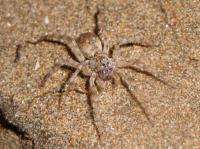Allocosa brasiliensis. Image credit: Nico Olejnik
(PhysOrg.com) -- While most people are familiar with the fact that many species of female spiders eat their male counterparts, new research findings published in the Biological Journal of the Linnean Society show how biologists have found a species with an apparent role reversal with the male eating the female.
Located in Uruguay, Dr. Anita Aisenberg and the team of biologists from the Clemente Estable Institute of Biological Research have been studying the Allocosa brasiliensis. This nocturnal wolf spider is found on South America's Atlantic Ocean coast and within the riverbank sand dunes. The study of these spiders began as they are an indicator of the coastal habitats health.
However, during this study, they observed a male spider eating a female spider and set out to determine if this behavior was normal for the species as it has never been observed before in any other species. Where female spiders are usually larger and the dominant of the two, the researchers have found that with the Allocosa brasiliensis, the male has a traditional role reversal.
The male spiders were observed waiting in their burrows for the females searching for mates. From what was observed by the researchers, the male spiders tended to mate with the younger, more productive virgin female spiders. The older, less productive female spiders were instead eaten by the male spider. It appears that the choice of whether to eat or mate with a female spider is based on the higher reproductive possibility.
The environment where the Allococa brasiliensis live is one of instability for the spiders and the prey is unpredictable. In addition to this the area offers extreme temperatures and strong winds. Dr. Aisenberg believes that this unstable environment may have been a contributing factor to the apparent role reversal and unusual sexual behavior.
More information: AISENBERG, A., COSTA, F. G. and GONZÁLEZ, M. (2011), Male sexual cannibalism in a sand-dwelling wolf spider with sex role reversal. Biological Journal of the Linnean Society, 102: no. doi: 10.1111/j.1095-8312.2011.01631.x
© 2010 PhysOrg.com





















